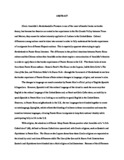The Borderlands in Puerto Rico : Creating New Identities
Author
Funderburk, Cheryl
Abstract
Gloria Anzaldúa's Borderlands/La Frontera is one of the most influential books on border theory, but because her theories are rooted in her experiences in the Rio Grande Valley between Texas and Mexico, they cannot be indiscriminately applied to all Latinos in the United States. Cultural differences among nations must be taken into account in order to fully understand the border experiences of immigrants from different Hispanic nations. This is especially apparent when trying to apply Borderlands to Puerto Rican literature. The differences in the political situations between Puerto Rican culture and the Chicana culture that Anzaldúa writes about require a reexamination of Anzaldúa's theories in order to apply them to the border experiences of Puerto Ricans in the U.S. This thesis looks at texts from three Puerto Rican authors--Rosario Ferré's The House on the Lagoon, Judith Ortiz Cofer's The Line of the Sun, and Nicholasa Mohr's In Nueva York--through the framework of Borderlands to see how the border experience of Puerto Ricans affects cultural changes in language, religion, and women's roles. The changes in language are eased somewhat by Puerto Rico's official policy of English-Spanish bilingualism. However, Spanish is still the cultural language of the island in much the same way that English is the cultural language of the United States and, as Ferré and Ortiz Cofer show, an inability to speak Spanish in Puerto Rico is as limiting as an inability to speak English in the United States. However, in Puerto Rican neighborhoods in the U.S., the two languages have blended together to create an interlanguage, Spanglish, which reflects the blending of cultures in these communities and eases the transition between languages, allowing Puerto Rican immigrants to keep their national identity while participating fully in life in the U.S. With religion, the situation is different. Many Puerto Ricans practice what Anzaldúa calls "a folk Catholicism" (49), defined as Roman Catholicism syncretized with Creole religions, such as Santería and Espiritismo in Puerto Rico. The House on the Lagoon shows how these Creole religions are separated on the island by racial and class differences while The Line of the Sun and In Nueva York illustrate how Santería and Espiritismo have blended into a third religion called Santerismo. Because of the differences between the Puerto Rican and U.S. interpretations of mental health, these religions are used as healing practices as well, supplanting American psychology for many Puerto Ricans living in the U.S., allowing them to keep a vital connection to island culture. The changes in women's roles in Puerto Rican culture are symbolized by the changes in the role of wives in family life. Anzaldúa's discussion of the influence of the Hispanic concepts of marianismo and machismo on family life exemplifies the limitations for Latinas who follow a traditional life in the U.S. However, as Ferré, Ortiz Cofer, and Mohr show in their works, these concepts can be manipulated, refined, and discarded by modern women, although these changes can be very difficult because family is an integral part of Latino and Hispanic cultures. Women who reject their traditional roles entirely risk being cut off from their culture, leaving them feeling adrift and alone in a strange land. The issues discussed in this thesis show how the borderlands between the U.S. and Puerto Rico are more psychological than the physical borderlands of Anzaldúa's experience. This causes distinct differences in the border experiences of Puerto Ricans which must be taken into account in order to fully understand the works of Puerto Rican authors both on the island and in the U.S.
Date
2010
Citation:
APA:
Funderburk, Cheryl.
(January 2010).
The Borderlands in Puerto Rico : Creating New Identities
(Master's Thesis, East Carolina University). Retrieved from the Scholarship.
(http://hdl.handle.net/10342/2829.)
MLA:
Funderburk, Cheryl.
The Borderlands in Puerto Rico : Creating New Identities.
Master's Thesis. East Carolina University,
January 2010. The Scholarship.
http://hdl.handle.net/10342/2829.
June 29, 2024.
Chicago:
Funderburk, Cheryl,
“The Borderlands in Puerto Rico : Creating New Identities”
(Master's Thesis., East Carolina University,
January 2010).
AMA:
Funderburk, Cheryl.
The Borderlands in Puerto Rico : Creating New Identities
[Master's Thesis]. Greenville, NC: East Carolina University;
January 2010.
Collections
Publisher
East Carolina University

